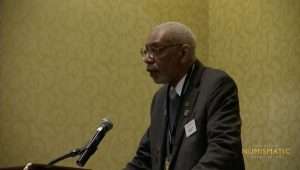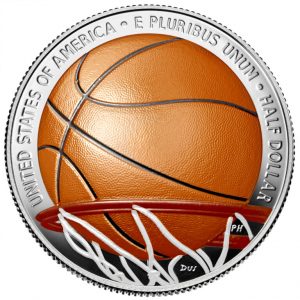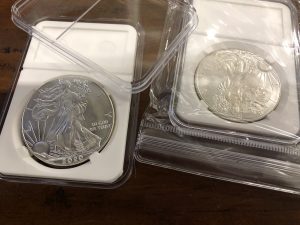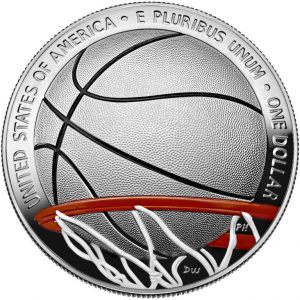National Money Show opens in (yawn) Colorado Springs
Colorado Springs is the home of the ANA’s headquarters, and it is about 75 miles south of Denver. Colorado Springs is also the home of the United States Air Force Academy. It is a nice place, and planning a visit should be on anyone’s destination list.
While it is nice that the National Money Show is in Colorado Springs, other cities could hold the show. The ANA refuses to consider holding any show in Washington, DC.
Regulations by the city’s government and the city council’s unresponsiveness to address the issues prevented the ANA from considering Washington for one of their shows.
Times have changed.
Since Larry Shepherd stuck the ANA with keeping the World’s Fair of Money in the Chicago area, Washington has new facilities to host the ANA shows.
Even though Washington is the home of the U.S. Mint, the Bureau of Engraving and Printing, and the Smithsonian National History Museum, where the National Numismatic Collection is located, the ANA cannot get past the memories of past problems to explore new opportunities.
The problem was driven home by Larry Shepherd, who said on an episode of the Coin World Podcast that Washington cannot hold an ANA show. Shepherd, who probably has not been to Washington since being dismissed as the ANA’s executive director, has no clue how his pronouncement is wrong.
The ANA can hold either show at the National Harbor, a development outside the Beltway in Oxon Hill, Maryland. Aside from being the location of an MGM Grand Hotel, the 2,000 room Gaylord National Resort & Convention Center can comfortably host the ANA.
But people like Larry Shepherd do not keep up with the present and do not know about National Harbor. Instead, they isolate themselves in their prejudices and ignorantly dismiss the ideas.
The Washington region can be a destination for collectors and their families. After all, Washington is the nation’s capital. Come for the show, stay for the history. Bring the kids. We can go to the Smithsonian American Art Museum to see the art of the artists who designed U.S. coins. Tour the city to see the statues by some of those same artists.
What if the ANA worked with the Smithsonian Institute to create exhibits around the coins and the history they represent. How fascinating will it be to take the Native American Dollar program and create a program to expand on their message at the National Museum of the American Indian?
Even though the Bureau of Engraving and Printing has brought interesting items to other shows, they can host special tours in their Washington printing center for ANA members.
When it is time to visit the bourse, it will be in the expansive convention center at the Gaylord Hotel. After the bourse closes, convention-goers can stay in National Harbor to have a good time, including a ride on the Capital Wheel overlooking the Potomac River.
Since National Harbor is in Maryland, the sales tax laws favor bringing all of the shows to the area.
Maybe Larry Shepherd is right. All Washington could do is add new educational opportunities and create family fun to increase the show’s attendance. It is not the direction it appears the ANA wants to go.
The Failures of the U.S. Mint’s Website Continues
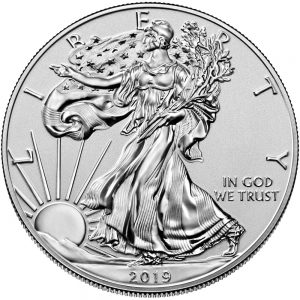 The subject line of the email contained the entire note. My correspondent asked, “Did you try to buy the 2019 Reverse Proof?”
The subject line of the email contained the entire note. My correspondent asked, “Did you try to buy the 2019 Reverse Proof?”
Reports said that the remainder of the products sold out in 10 seconds. That was probably the same 10 seconds the U.S. Mint’s website seemed to freeze.
I admit that I tried cheating. As a retired programmer, I tried to script the purchase. The script watched the clock, and right at noon, the script tried to place the coin in my bag then transfer the payment page to the browser. But for the seconds after high-noon, the site did not respond. Frozen!
The best solution offered for these situations is a lottery system. Reports suggested that the suggestion was made to Director David Ryder. Ryder, like the last appointed director, is tone-deaf to the collectors. Some day, the U.S. Mint will have a competent director.
Weekly World Numismatic News for August 9, 2020
 The U.S. Mint does it again by shutting out collectors with an unannounced change in procedures.
The U.S. Mint does it again by shutting out collectors with an unannounced change in procedures.
According to reports, 95 of the 2019-S American Silver Eagle Enhanced Reverse Proof did not sell the first time because of an alleged glitch. Rather than letting the general public know that the coins were available, they snuck it onto their website and sent messages to people who signed up for reminders only.
The U.S. Mint did not send the message to everyone on their reminder list. Only to those people who signed up for when the coin would be available again.
So let me get this straight. If you’ve signed up for the U.S. Mint reminder services but not for restocking notice, you did not get notified. But if you signed up for a restocking notice after the U.S. Mint announced that all 30,000 coins sold, you were sent a notice.
From the poorly designed website with a bad ordering experience to the sneaking the surplus coins by the general public, the U.S. Mint is not endearing itself to the collecting public.
How can the hobby expect to attract more collectors if the source of coins makes it difficult to purchase their products?
And now the news…
 → Read more at canadiancoinnews.com
→ Read more at canadiancoinnews.com
 → Read more at bbc.com
→ Read more at bbc.com
 → Read more at timesnownews.com
→ Read more at timesnownews.com
 → Read more at thestacker.com
→ Read more at thestacker.com
Weekly World Numismatic News for August 2, 2020
People invested in a tradition are afraid to change. It has always been that way and was successful, then why change?
At some point, change is necessary, or the tradition will stifle growth. Two areas where tradition is holding back activities are baseball and numismatics.
Hardcore baseball fans are the most traditional fans. They are the people who can tell you who was on deck when Bobby Thompson hit “the shot heard around the world,”† the nuance of the double switch, or why on-base percentage is a better statistic than batting average.
While trying to have a season amidst the COVID-19 pandemic, baseball had to look tradition in the face and calmly walk in another direction. Aside from adding the designated hitter (DH) in the National League was placing a runner on second base when the games go into extra innings. The purpose is to shorten games, especially those that go to extra innings.
We are used to the DH. When games are played in an American League Park, all teams use the DH. But putting the runner on second base who did not get a hit to be there is very different.
But the move seems to be working. In the first week of the new season, four games went to extra innings, and all of the games ended in the 10th inning. It is an unorthodox move for a sport bound in tradition.
Numismatics is the same in many respects. The U.S. Mint strikes real coins, not trinkets. To be a real collector, you have to collect all of the best stuff, including the highest grade versions of the most popular coins. Finally, coins have to be a good value.
A “real coin” is money that an issuing authority legally monetizes for a market. The market may be for collecting purposes, but the issuer has assigned a face value. Even though the U.S. Mint has issued commemorative coins that are not intended to circulate, the traditionalists have determined the new colorized coin is something less than a real coin.
Traditionalists may not want to hear that a general collector community has reacted favorably to the colorized Naismith Hall of Fame Commemorative Coins. On message boards where collectors discuss their collections, they are now beginning to realize that the U.S. Mint has issued other sports-related commemorative coins. In a recent discussion, some started to ask about the National Baseball Hall of Fame commemorative coins.
These collectors are not interested in Morgan Dollars, Standing Liberty Quarters, or Buffalo Nickels. They want the coins to add to their sports collections. A fan of Dr. J, Julius Erving, said that he plans to buy the colored and non-colored coins for his collection.
When it comes to numismatics, what defines a good value? How does one tell a person who may have inherited coins why a dealer would buy a coin for $20 but sell it for $45 or $50?
This past week, Michael Taylor, a financial writer for mysanantoinio.com, wrote the article, “Coin collecting a fine hobby, but not a good investment.” His fundamental question was, why is the spread between the bid and ask prices of coins so vast.
Briefly, Taylor acquired coins from his elderly father and tried to figure out their value. His mother had taken the small hoard to a coin shop and was offered about half of their retail value. As part of Taylor’s investigation, he used the Red Book (A Guide Book of United States Coins) and the Blue Book (Handbook of United States Coins) to understand pricing.
Taylor concluded that coins were not a good investment based on his analysis of the pricing differences found in both books.
Taylor is a published financial professional with many years of understanding markets. Most markets are very understandable that professionals who predict markets can do so with reasonable certainty. They can mitigate risks for wrong predictions and still make a good living.
Based on analyzing the Red and Blue books, how does one do that in the coin market? The problem is that there is so much more to the market that these books do not cover. A lot is based on tradition, unwritten lore, and irresponsible perceptions.
The general public has a better understanding of the automobile market than they do of the numismatic markets.
If you want to fix the hobby, it is time to look at these traditions, lore, and perceptions and act responsibly. Otherwise, the collectors may only be one-time coin buyers, and the hobby will continue to stagnate.
And now the news…
 → Read more at spectrumnews1.com
→ Read more at spectrumnews1.com
 → Read more at bloomberg.com
→ Read more at bloomberg.com
 → Read more at mysanantonio.com
→ Read more at mysanantonio.com
 → Read more at nytimes.com
→ Read more at nytimes.com
 → Read more at markets.businessinsider.com
→ Read more at markets.businessinsider.com
 → Read more at weartv.com
→ Read more at weartv.com
 → Read more at bbc.com
→ Read more at bbc.com
Those Cheap Silver Eagles Are A Chinese SCAM!
- The scammers are in Shenzen, China
- It may be more than one person behind the scam, but they are working together.
- There appears to be a pocket of these scammers in the Middle East. Early analysis suggests they are in Doha, Qatar.
- All email addresses are either on Gmail or use Google’s professional services that allow Gmail to look like a real domain.
- Any of these sites that have a U.S.-based telephone number are using burner phones. For those not familiar with the term, a burner phone is one on a pay-as-you-go plan. The phones are cheap, easily disposed of, and are difficult to trace.
- Any of these sites that use a U.S.-based physical address use a dropbox service from a logistics company. The dropbox service is a locker that the company pays as a way to manage shipping remotely. There are legitimate uses for these dropbox services, but these scammers use them to make it look like they are located in the United States.
- The scammers are using branded gift cards to pay for these services.
While investigating these sites, I learned that there are five tips that, if followed, you will avoid being scammed.
- NO LEGITIMATE DEALER IS SELLING BULLION COINS FOR BELOW THE SPOT PRICE!
The current price of silver is $23.43 per troy ounce. If anyone is selling American Silver Eagles for less, they are likely trying to sell counterfeit coins. - IF THE DEAL IS TOO GOOD TO BE TRUE, IT LIKELY IS NOT A GOOD DEAL!
When purchasing bullion and coins from dealers, the price between the spot price and the price the dealer will sell the coins for is called the spread. The spread can change based on inventory, availability, and other market forces. It is rare when the spread is less than 5-percent. Some of the largest dealers will lower their spread for their better customers or as a special to lure other customers. A good deal is when the spread is less than 5-percent. However, the spread is rarely less than 2-percent. If a legitimate dealer sells metals for less than 2-percent over the spot price, that is a good deal. These companies are not in business to lose money. Be very worried if someone is trying to sell bullion coins for less. - IF THE DEALER DOES NOT IDENTIFY THEMSELVES ON THEIR WEBSITE, THEY ARE LIKELY HIDING SOMETHING.
On every website that is likely selling counterfeit coins, they have a wonderfully written “About Us” page that says nothing. The Of the four websites that readers have sent to ask if they were legitimate, all of the “About Us” pages were copies. A web search using sample passages from the page yielded thousands of results. - IF THE CONTACT PAGE DOES NOT HAVE LEGITIMATE CONTACT INFORMATION, THEY ARE LIKELY HIDING SOMETHING.
One of the indicators of a site owned by Chinese scammers is if they give you hours in HKT or Hong Kong Time. These scammers are not in Hong Kong but are in Shenzen, which is in the same time zone. - IF THE SITE IS “POWERED BY SHOPLAZZA,” IT IS LIKELY A SCAMMER SITE.
Go to the bottom of any page. If there is a copyright statement followed by “Powered by Shoplazza,” then run away. Shoplazza is a newly created service out of China that seems to be a Shopify clone made by reading Shopify’s HTML. While looking at the HTML code, there are indications that the site was created quickly. During a quick look at three sites highly suspected of selling counterfeit American Silver Eagle coins, I was able to confirm that their sites are hosted on Shoplazza.
Since my first post about these Chinese scammers, I have received at least five notes per week saying they bought ten coins from these websites. Everyone that received the coins and was able to weigh them found they weigh only 25 grams. A real American Silver Eagle coin should weigh 31.103 grams.
Yes, I bought two coins from one of the sites, but I did so for educational purposes. I suspected that these would be counterfeit, and I wanted the coins to learn more about them. I believe they are silver plated. As for what is under the silver plate, I have to wait until I can visit a dealer with one of those devices that can analyze coins.
Please do not buy from them.
- The font for LIBERTY is too thin. Also, the stars in her flag draped over the shoulder are too small.
- Aside from the rims being to thin, look at the U in United and the dash between SILVER and ONE. These are not correct for the 2020 ASE.
Weekly World Numismatic News for July 26, 2020
No, the tragedy is not the alleged coin shortage.
Social media went berzerk because the U.S. Mint is going to sell colorized versions of the Basketball Hall of Fame Commemorative Coins.
How dare the U.S. Mint do something like this? It’s… it’s… un-American!
Calm down, folks. It is only a little color enhancing a commemorative coin.
But it’s not what the U.S. Mint is supposed to be about. They are supposed to produce real coins.
Real coins? Like the mess of coins in what we refer to as the Classic Commemorative Era? Can we also consider the circulating coinage disasters like the steel cent and Susan B. Anthony dollar?
It will turn us into Canada!
I can think of worse places. I like Canada. I have family in Canada. I collect Canadian coins. However, it is not going to turn the U.S. Mint into the Royal Canadian Mint. First, the Royal Canadian Mint produces more non-circulating legal tender (NCLT) coins that the U.S. Mint. Second, the Royal Canadian Mint uses technologies like lenticular printing to create the design. For the Basketball Hall of Fame coin, the colorization is an enhancement of a struck design.
It’s ugly!That is your opinion. I like what the U.S. Mint will do to the half-dollar coin by emphasizing the ball and rim. Based on the pictures I have seen, the colorized rim on the silver dollar is not enough.
It’s not what the U.S. Mint is supposed to do. I’m not buying it!
Good! It means that I will be able to buy one for myself without trying to fight the speculators.
It’s too expensive.
Finally, an argument I can agree with. Yes, the U.S. Mint is charging too much for the colorized coins. This is because instead of bringing the technology in-house, they have to pay a contractor to do the colorization.
It’s bad for the hobby!
How many times have we heard something is wrong for the hobby. Slabs signed by television reality stars were supposed to be the beginning of the end of the hobby. Endless series of circulating commemoratives are supposed to be bad for the hobby. Commemorative coins with unpopular themes were also going to kill the hobby.
To borrow a phrase: We’re still standing. Yeah! Yeah! Yeah!
Sorry, boys and girls (and we know the complaints are mostly coming from old men). Colorized commemorative coins are not bad for the hobby. It could be good for the hobby. These coins could attract people to the hobby that may not have been interested in the past.
If you want to know what is not good for the hobby, it is the U.S. Mint selling coins that did not sell at cut-rate prices to a television huckster like RCTV that pays NGC to slab the coins with special labels and then sells them at hugely inflated prices to unknowledgeable people on television.
You may also watch for the U.S. Mint’s “de-trashing” policy that is dumping other surplus coins on the market. These are coins that did not sell during the regular sales period that will have “special designation” labels from NGC. Not that the labels would make a difference, but we know that the dealers will over-hype these coins at prices far beyond their worth.
Remember what happened with the television hucksters selling state quarters at over-inflated prices? Or even RCTV selling a set of 31 American Silver Eagle bullion coins for more than you can buy a date run of 34 coins? Eventually, these coins will end up being brought to dealers who will tell them that they overpaid.
I will take colorized coins over the feeding crap to the television hucksters any day.
And now the news…
 → Read more at kitco.com
→ Read more at kitco.com
 → Read more at fastcompany.com
→ Read more at fastcompany.com
 → Read more at spenboroughguardian.co.uk
→ Read more at spenboroughguardian.co.uk
 → Read more at barrons.com
→ Read more at barrons.com
 → Read more at savingadvice.com
→ Read more at savingadvice.com
 → Read more at cnn.com
→ Read more at cnn.com
